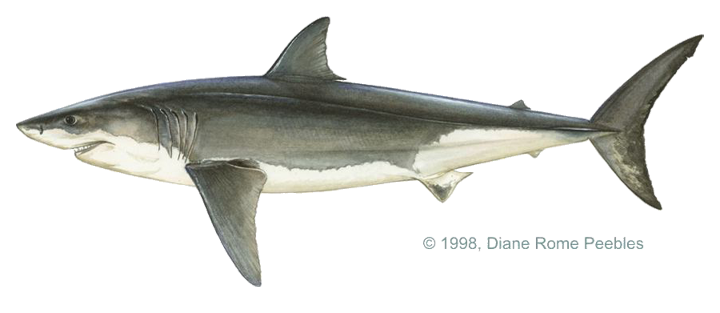Game Fish Identification Reference Guides
Shark, white
(Carcharodon carcharias)
(Carcharodon carcharias)

(Linnaeus, 1758); LAMNIDAE FAMILY; also called great white shark, white pointer, white death, man eater
Occurs worldwide, most commonly in cool temperate seas. It is best known in parts of the central and western Pacific, especially off Australia and New Zealand. On the Pacific coast of the U.S. it stays in the cool, southbound in shore current off California, but does not occur in California's warmer off shore waters. It is known to occur as far north as Nova Scotia in the western Atlantic and northern Spain in the eastern Atlantic. In the winter it occurs south of Florida, the Gulf of Mexico and the West Indies. It is also known to enter the Mediterranean Sea.
Though basically a deep water oceanic species, it does come in fairly close to shore off California because of the cool current and to feed on marine mammals. It also frequents Australian and South African beaches and is suspected of entering saltwater creeks.
The snout is conical and ends in a point, hence the name “white pointer”. There is a large, very prominent, flattened keel on either side of the caudal peduncle. It can be distinguished from all other sharks by its teeth, which are large and triangular like stone arrowheads, with sharp, serrated cutting edges. The great “white” shark is actually a grayish brown color above, fading to an off white on the belly. The pectoral fins are black tipped, and there is a black oval spot on the body just above them.
Its diet includes fish, squid and other sharks as well as sea turtles, seals, sea lions, and sea gulls. This shark has attacked small boats, sometimes sinking them, and has been known to take a larger boat by the propeller and shake it.
Fishing methods include bait fishing with large fish chunks while chumming and also trolling.
Despite its infamy, the great white shark is a relatively uncommon species. It reaches sexual maturity at a length of 11 14 ft (3 4 m). It is probably the most dangerous of all sharks as far as size, strength, ability and disposition to attack are concerned. The flesh is edible, though rarely eaten
Occurs worldwide, most commonly in cool temperate seas. It is best known in parts of the central and western Pacific, especially off Australia and New Zealand. On the Pacific coast of the U.S. it stays in the cool, southbound in shore current off California, but does not occur in California's warmer off shore waters. It is known to occur as far north as Nova Scotia in the western Atlantic and northern Spain in the eastern Atlantic. In the winter it occurs south of Florida, the Gulf of Mexico and the West Indies. It is also known to enter the Mediterranean Sea.
Though basically a deep water oceanic species, it does come in fairly close to shore off California because of the cool current and to feed on marine mammals. It also frequents Australian and South African beaches and is suspected of entering saltwater creeks.
The snout is conical and ends in a point, hence the name “white pointer”. There is a large, very prominent, flattened keel on either side of the caudal peduncle. It can be distinguished from all other sharks by its teeth, which are large and triangular like stone arrowheads, with sharp, serrated cutting edges. The great “white” shark is actually a grayish brown color above, fading to an off white on the belly. The pectoral fins are black tipped, and there is a black oval spot on the body just above them.
Its diet includes fish, squid and other sharks as well as sea turtles, seals, sea lions, and sea gulls. This shark has attacked small boats, sometimes sinking them, and has been known to take a larger boat by the propeller and shake it.
Fishing methods include bait fishing with large fish chunks while chumming and also trolling.
Despite its infamy, the great white shark is a relatively uncommon species. It reaches sexual maturity at a length of 11 14 ft (3 4 m). It is probably the most dangerous of all sharks as far as size, strength, ability and disposition to attack are concerned. The flesh is edible, though rarely eaten












